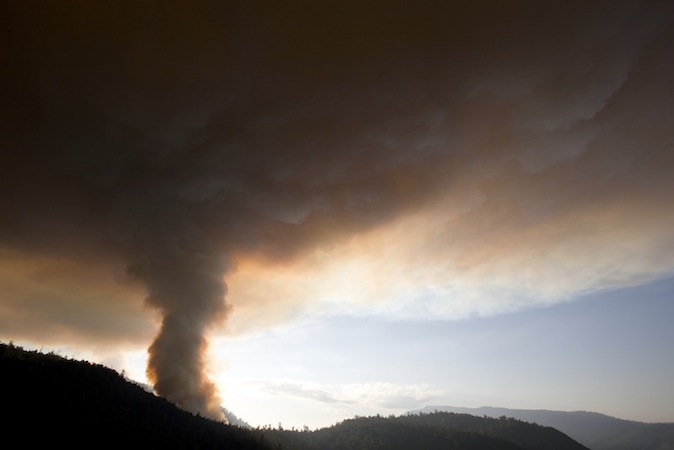Carbon reduction measures won’t be enough to get us to our targets while we continue to overlook significant emission sources. [15 March 2011 | Peter Boyer]
If ever there was an issue custom-designed for political carnage, it’s human-induced climate change.

Thousands of tonnes of carbon, as carbon dioxide gas and black carbon particles, spiral into the Tasmanian atmosphere in a forest regeneration burn in Tasmania’s Weld Valley. PHOTO ROB BLAKERS
In the battle to secure effective policy to cut carbon emissions, John Howard, Malcolm Turnbull and Kevin Rudd were early casualties. If you believe in Newspoll, Julia Gillard will be next. The task is starting to look like a death march.
All the elements are there for a real mess. Huge, complex physical processes and awkward questions about long-term sustainability have come up hard against three-word slogans and three-year electoral cycles.
Political-speak is masking a very uncomfortable reality. Nearly 20 years after the Rio agreement to “prevent dangerous anthropogenic interference with the climate system” by stabilising emissions, policies that effectively tackle all major sources of carbon pollution still seem a far-away dream.
At this rate, securing effective global agreements will take at least 20 more years, too close for comfort to the 2050 deadline for state and national targets. Somehow we have to speed up the process, while also ensuring that it covers all the big sources of emissions. A tough call indeed.
At present, some significant emissions sources are being repeatedly overlooked. Embodied energy is one, a problem well-illustrated by the case of Hobart’s 1960s government office block whose impending demolition was criticised by Greg Barnes in “The Mercury” last week.
A consultant’s advice that replacing the existing structure with a “five-star green-rated” one will yield a net energy saving is pure greenwash. It glosses over the energy lost in demolishing a sound structure and erecting a brand new one, with all the energy embodied in making, moving and assembling its component parts.
Far better to keep what we have and improve its energy-efficiency. It’s not a pretty building, but I’ve lived with it most of my life, and in the interests of good energy policy the rest of us can too.
But the biggest imponderable in current carbon accounting is about land use, responsible for somewhere between 18 and 50 per cent of global carbon emissions. We hear better practices could dramatically cut emissions, but we need to know more about the processes and quantities involved.
Early this month, in the fourth of seven scheduled updates to his 2008 climate change review, Professor Ross Garnaut said changes in rural land management may be a “seriously big” factor in reducing carbon emissions, while earning money in carbon credits for landowners who store carbon in soils, reduce livestock methane emissions or plant trees.
Agriculture is to be excluded from the proposed carbon tax regime, but the government’s “Carbon Farming Initiative” (CFI), scheduled to come into effect in July, will allow farmers to sell credits at a market price. As yet, farmers generally seem doubtful about prospects for profit.
The role of native forest management in cutting emissions is now firmly in Garnaut’s sights. “Emissions reductions and biosequestration in harvested native forests,” he said, “could be achieved through reducing the area harvested, or potentially through changes in harvesting practice”.
Garnaut believes a stop to harvesting of Tasmania’s mature forests “could deliver mitigation benefits”. He cited a CSIRO estimate that emissions saved Australia-wide by ending native forest harvesting could amount to 47 million tonnes of carbon dioxide each year from 2010 to 2050.
A UN report released a fortnight ago suggests that stopping slash-and-burn forestry may further mitigate global warming by reducing heat-trapping black carbon, present in smoke from burning. The warming impact of these carbon particles, while short-lived, is from 100 to 2000 times greater than that of carbon dioxide.
In the absence of uncontested data or any open, objective assessment of forest practices, we have to live with the paradox of Premier Lara Giddings writing of “enormous carbon stores across our forest estate” while allowing Forestry Tasmania’s burning regime to continue unabated.
If such debate is tricky at a state or national level, in the international arena it’s many times more complex. Out of that complexity may yet come some benefits for our carbon bottom line.
For all the difficulties of recent UN climate summits, there has been progress in negotiations about land use. A UN meeting in April, to examine the climate impact of land use in developed countries such as Australia, aims to close notorious loopholes in accounting rules agreed at Kyoto in 1997.
Among these loopholes is a failure to account for logging emissions in developed countries. Aware that perverse international land-use rules may undermine its much-vaunted CFI, Australia may have to support closing the loopholes, and that has big implications for future land use in Tasmania.
Present progress under Kyoto rules gives little prospect for Tasmania to achieve its legislated 2050 emissions target of 60 per cent below 1990 levels; even less for climate change minister Nick McKim’s proposed 25 per cent target for 2020.
A new regime in which carbon storage was actively pursued in managing farms and forests, besides dramatically improving those prospects, could even allow higher targets to be set.
